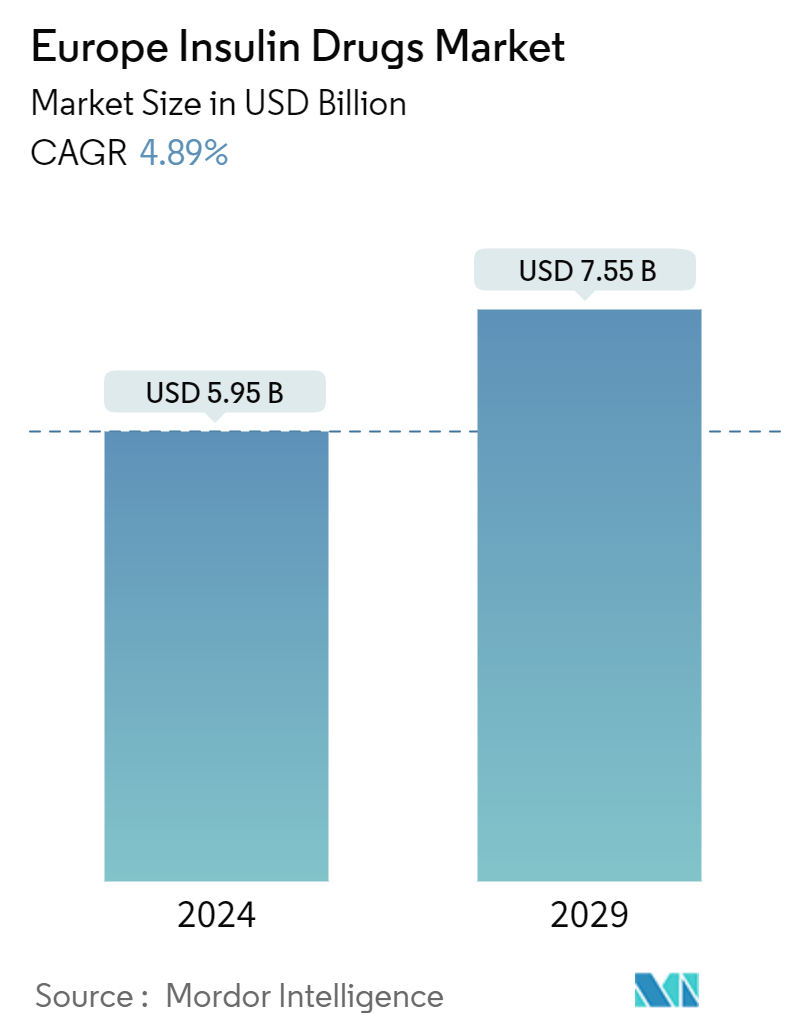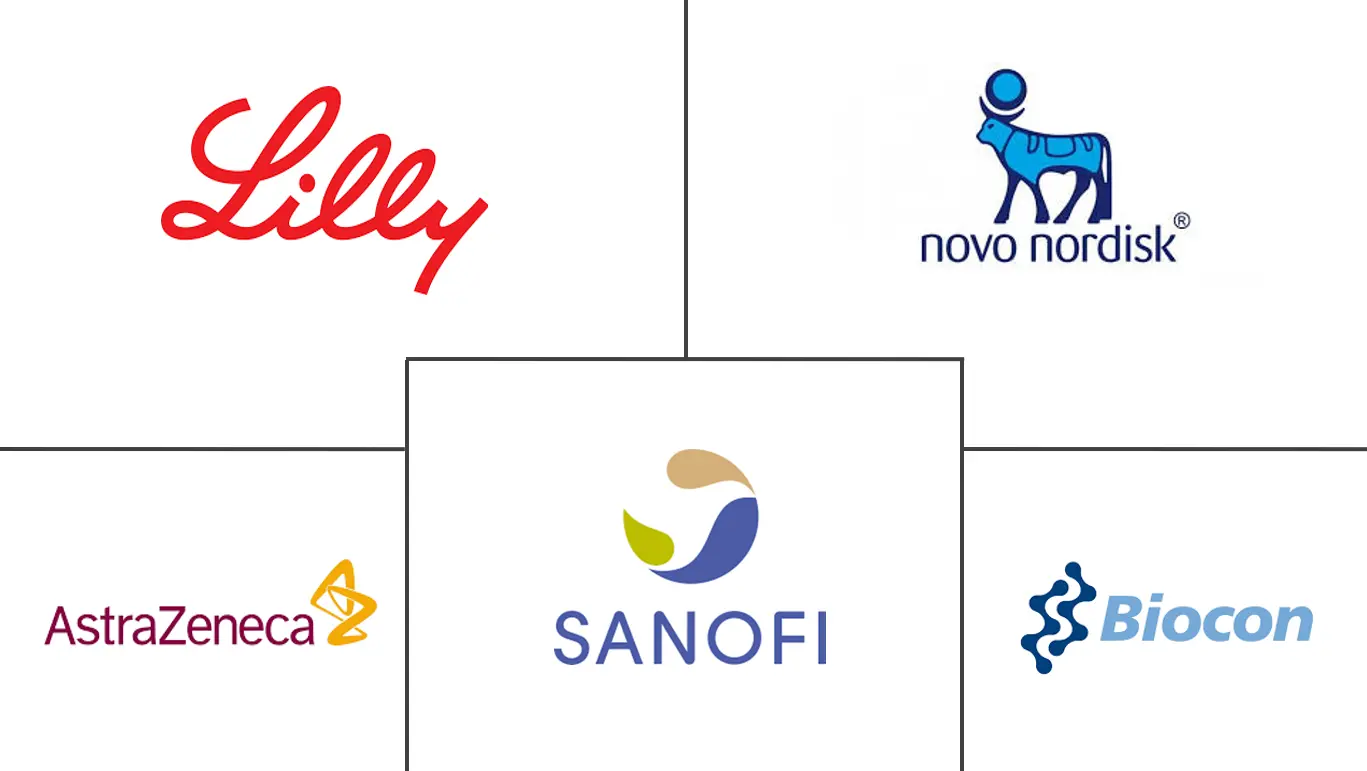Market Size of Europe Insulin Drugs Industry

| Study Period | 2018 - 2029 |
| Base Year For Estimation | 2023 |
| Market Size (2024) | USD 5.95 Billion |
| Market Size (2029) | USD 7.55 Billion |
| CAGR (2024 - 2029) | 4.89 % |
| Market Concentration | High |
Major Players
*Disclaimer: Major Players sorted in no particular order |
Europe Insulin Drugs Market Analysis
The Europe Insulin Drugs Market size is estimated at USD 5.95 billion in 2024, and is expected to reach USD 7.55 billion by 2029, growing at a CAGR of 4.89% during the forecast period (2024-2029).
Diabetes is a condition that is more commonly found among older individuals. In Europe countries, there are approximately 25 million people between the ages of 60 and 79 who have diabetes. While middle-aged men (between 40 and 59 years old) tend to have a higher prevalence of diabetes compared to women, the number of women with diabetes increases significantly after the age of 70. This can be attributed to the fact that women generally have a longer life expectancy.
In 2023, the average prevalence of diabetes among adults in EU countries was 7.5%, taking into account diagnosed cases and age-standardization. However, the rates varied across different countries. Cyprus, Portugal, and Germany had rates of 9% or higher, while Ireland and Lithuania had rates of less than 4%.
It is worth noting that the prevalence of diabetes seems to have reached a stable point in many European countries in recent years, particularly in Nordic countries. However, there has been a slight increase in diabetes rates in Southern European countries as well as Central and Eastern European countries. These upward trends can be attributed, at least in part, to the rise in obesity and physical inactivity, and how these factors interact with the aging population.
The European countries are suffering from the burden of high diabetes expenditure due to its rising prevalence. Approximately 10% of the total diabetes population is having type-1 diabetes and approximately out of this 10% of people only 80-90% use Insulin but the usage of insulin is rising from time to time, even type-2 diabetes patients are using the insulin drugs during COVID-19. Technological advancements have increased over the period in Insulin drugs.
Therefore, owing to the aforementioned factors the studied market is anticipated to witness growth over the analysis period.
Europe Insulin Drugs Industry Segmentation
Human insulin is used to control blood sugar in people with type-1 diabetes, a condition in which the body cannot produce insulin and cannot, therefore, control the amount of sugar in the blood, or type-2 diabetes, a condition in which the blood sugar is too high because the body cannot produce or use insulin normally and which cannot be controlled by oral medications alone. The European insulin drugs market is segmented into type and geography. The report offers the value (in USD) and volume (in units) for the above segments.
| Insulin | |||||||
| |||||||
| |||||||
| |||||||
| |||||||
|
| Geography | |
| United Kingdom | |
| Germany | |
| France | |
| Russia | |
| Spain | |
| Italy | |
| Rest of Europe |
Europe Insulin Drugs Market Size Summary
The European insulin market is poised for significant growth over the forecast period, driven by the increasing prevalence of diabetes across the region. The aging population, coupled with rising obesity rates and sedentary lifestyles, has contributed to a stable yet concerning prevalence of diabetes, particularly in Southern, Central, and Eastern European countries. The market is characterized by a high demand for insulin drugs, as both type-1 and type-2 diabetes patients require effective management solutions to maintain blood glucose levels. Technological advancements in insulin delivery and monitoring systems are further propelling market growth, with new products and collaborations enhancing treatment options. The market landscape is dominated by a few major players, with strategic alliances and regulatory support in countries like Germany fostering a conducive environment for innovation and expansion.
The healthcare expenditure related to diabetes in Europe is substantial, with a significant portion of healthcare budgets allocated to managing the disease. Germany, in particular, stands out with its advanced healthcare infrastructure and regulatory frameworks that support diabetes care. The country's focus on high-quality care and active self-management is crucial in addressing the rising incidence of type-2 diabetes. The European insulin market benefits from a consolidated structure, with key players such as Novo Nordisk, Sanofi, and Eli Lilly leading the charge in developing and commercializing insulin products. Recent approvals and clinical trials, such as those by Medtronic and Novo Nordisk, highlight the ongoing innovation in insulin delivery systems and formulations, ensuring that the market remains dynamic and responsive to the needs of diabetic patients.
Europe Insulin Drugs Market Size - Table of Contents
-
1. MARKET DYNAMICS
-
1.1 Market Overview
-
1.2 Market Drivers
-
1.3 Market Restraints
-
1.4 Porter's Five Forces Analysis
-
1.4.1 Bargaining Power of Suppliers
-
1.4.2 Bargaining Power of Consumers
-
1.4.3 Threat of New Entrants
-
1.4.4 Threat of Substitute Products and Services
-
1.4.5 Intensity of Competitive Rivalry
-
-
-
2. MARKET SEGMENTATION
-
2.1 Insulin
-
2.1.1 Basal or Long-acting Insulins
-
2.1.1.1 Lantus (Insulin Glargine)
-
2.1.1.2 Levemir (Insulin Detemir)
-
2.1.1.3 Toujeo (Insulin Glargine)
-
2.1.1.4 Tresiba (Insulin Degludec)
-
2.1.1.5 Abasaglar (Insulin Glargine)
-
-
2.1.2 Bolus or Fast-acting Insulins
-
2.1.2.1 NovoRapid\Novolog (Insulin Aspart)
-
2.1.2.2 Humalog (Insulin Lispro)
-
2.1.2.3 Apidra (Insulin Glulisine)
-
2.1.2.4 FIASP (Insulin Aspart)
-
2.1.2.5 Admelog (Insulin Lispro)
-
-
2.1.3 Traditional Human Insulins
-
2.1.3.1 Novolin\Actrapid\Insulatard
-
2.1.3.2 Humilin
-
2.1.3.3 Insuman
-
-
2.1.4 Insulin Combinations
-
2.1.4.1 NovoMix (Biphasic Insulin Aspart)
-
2.1.4.2 Ryzodeg (Insulin Degludec and Insulin Aspart)
-
2.1.4.3 Xultophy (Insulin Degludec and Liraglutide)
-
2.1.4.4 Soliqua/Suliqua (Insulin Glargine and Lixisenatide)
-
-
2.1.5 Biosimilar Insulins
-
2.1.5.1 Insulin Glargine Biosimilars
-
2.1.5.2 Human Insulin Biosimilars
-
-
-
2.2 Geography
-
2.2.1 United Kingdom
-
2.2.2 Germany
-
2.2.3 France
-
2.2.4 Russia
-
2.2.5 Spain
-
2.2.6 Italy
-
2.2.7 Rest of Europe
-
-
Europe Insulin Drugs Market Size FAQs
How big is the Europe Insulin Drugs Market?
The Europe Insulin Drugs Market size is expected to reach USD 5.95 billion in 2024 and grow at a CAGR of 4.89% to reach USD 7.55 billion by 2029.
What is the current Europe Insulin Drugs Market size?
In 2024, the Europe Insulin Drugs Market size is expected to reach USD 5.95 billion.

